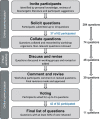Key questions in marine mammal bioenergetics
- PMID: 35949259
- PMCID: PMC9358695
- DOI: 10.1093/conphys/coac055
Key questions in marine mammal bioenergetics
Abstract
Bioenergetic approaches are increasingly used to understand how marine mammal populations could be affected by a changing and disturbed aquatic environment. There remain considerable gaps in our knowledge of marine mammal bioenergetics, which hinder the application of bioenergetic studies to inform policy decisions. We conducted a priority-setting exercise to identify high-priority unanswered questions in marine mammal bioenergetics, with an emphasis on questions relevant to conservation and management. Electronic communication and a virtual workshop were used to solicit and collate potential research questions from the marine mammal bioenergetic community. From a final list of 39 questions, 11 were identified as 'key' questions because they received votes from at least 50% of survey participants. Key questions included those related to energy intake (prey landscapes, exposure to human activities) and expenditure (field metabolic rate, exposure to human activities, lactation, time-activity budgets), energy allocation priorities, metrics of body condition and relationships with survival and reproductive success and extrapolation of data from one species to another. Existing tools to address key questions include labelled water, animal-borne sensors, mark-resight data from long-term research programs, environmental DNA and unmanned vehicles. Further validation of existing approaches and development of new methodologies are needed to comprehensively address some key questions, particularly for cetaceans. The identification of these key questions can provide a guiding framework to set research priorities, which ultimately may yield more accurate information to inform policies and better conserve marine mammal populations.
© The Author(s) 2022. Published by Oxford University Press and the Society for Experimental Biology.
Figures




References
-
- Acevedo J, Urbán J (2021) Estimates of Fuegian sprat consumption by humpback whales in the Magellan Strait feeding area as predicted by a bioenergetic model. Mar Ecol Prog Ser 657: 223–239.
-
- Aoki K, Isojunno S, Bellot C, Iwata T, Kershaw J, Akiyama Y, Martín López LM, Ramp C, Biuw M, Swift Ret al. (2021) Aerial photogrammetry and tag-derived tissue density reveal patterns of lipid-store body condition of humpback whales on their feeding grounds. Proc R Soc B Biol Sci 288: 20202307. - PMC - PubMed
-
- Arnbom T, Fedak MA, Boyd IL (1997) Factors affecting maternal expenditure in southern elephant seals during lactation. Ecology 78: 471–483.
-
- Arnould J, Boyd IL, Socha DG (1996a) Milk consumption and growth efficiency in Antarctic fur seal (Arctocephalus gazella) pups. Can J Zool 74: 254–266.
LinkOut - more resources
Full Text Sources

